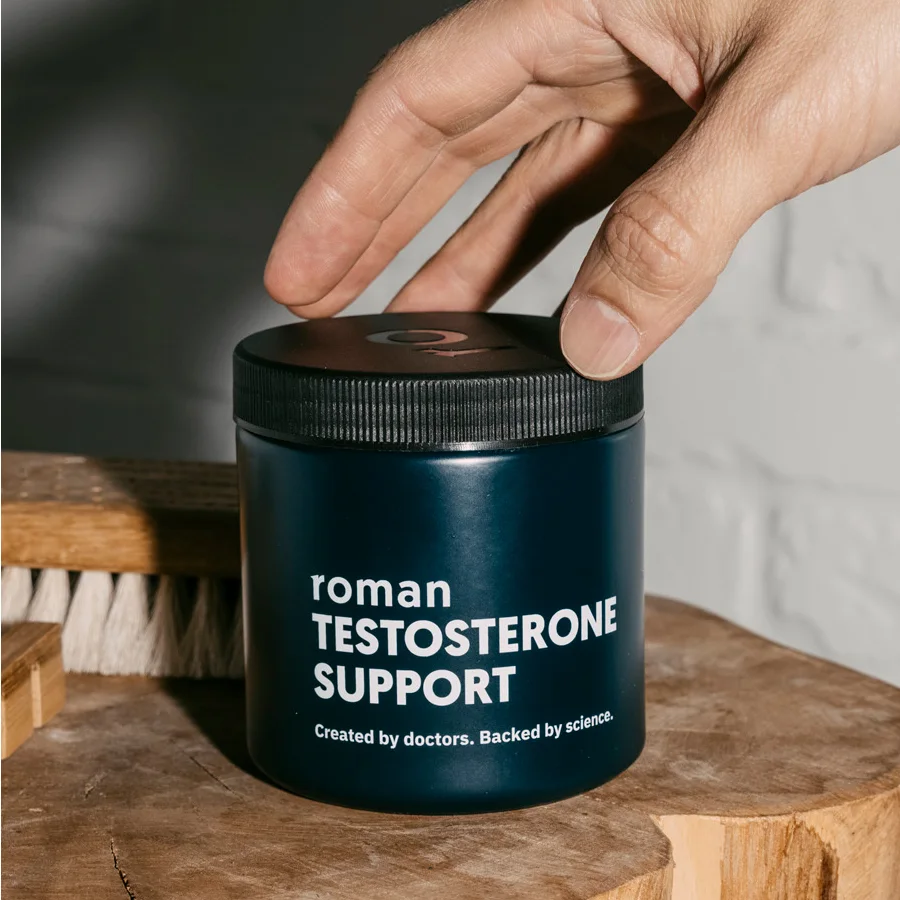Key takeaways
Low testosterone (aka low T) is unusually low levels of testosterone, a sex hormone, in the blood.
Signs of low testosterone can include low libido, sexual dysfunction, infertility, decreased muscle mass, bone weakness, mood changes, and more.
While testosterone levels decrease as you age, many other factors can also cause low T.
Here's what we'll cover
Here's what we'll cover
Here's what we'll cover
Key takeaways
Low testosterone (aka low T) is unusually low levels of testosterone, a sex hormone, in the blood.
Signs of low testosterone can include low libido, sexual dysfunction, infertility, decreased muscle mass, bone weakness, mood changes, and more.
While testosterone levels decrease as you age, many other factors can also cause low T.
Testosterone often gets a bad rap due to its association with aggression and dominance, but its role extends far beyond these stereotypes. While it might be best-known for its impact on male development during puberty, testosterone is crucial for overall health at every age. When testosterone levels decline, it can lead to symptoms that affect your quality of life. Fortunately, there are ways to address and manage these issues.
Here’s what to know about the signs of low testosterone and how to treat it.
What is low testosterone?
Low testosterone (which is sometimes known as hypogonadism or low T) is an abnormally low level of testosterone in the blood.
Testosterone is an androgen, or male sex hormone, that’s present in all sexes, meaning both those assigned male and those female at birth (i.e. typically men and women) can experience low T. However, since the hormone is naturally higher in males, this article will focus on low testosterone in that population.
In males, the testicles and adrenal glands produce testosterone; the hormone is present from birth and contributes to the development of male sexual organs. During puberty, levels of testosterone surge, producing secondary sexual characteristics, such as muscle growth, body hair, and sperm production. But testosterone plays an important role throughout your life, regulating libido, erectile function, sperm production, bone density, muscle mass, mood stability, and more.
Testosterone levels drop naturally with age, beginning in your 30s and 40s. While aging is a common cause, many other factors can also lead to decreased testosterone levels. We'll explore these causes in more detail later in the article.
Signs and symptoms of low testosterone
Testosterone influences several body systems and functions, so symptoms can be diverse and sometimes unexpected. Symptoms of low testosterone in men can include:
1. Low sex drive
Sex drive, or libido, is influenced by a range of physical, mental, and social factors and can vary widely from person to person and even day to day. While it’s normal for sexual desire to decrease with age, a significant drop in libido can be a sign of low testosterone.
2. Erectile dysfunction
Erectile dysfunction (ED) can manifest as fewer spontaneous erections, difficulty getting erections during sexual activity, or fewer morning erections. Essentially, ED is a condition where you cannot get or maintain an erection long enough to have a satisfying sex life. Many conditions can cause ED, including low testosterone levels.
3. Fatigue
Sleep disturbances, such as sleep apnea, may lead to low testosterone levels. This may occur because most of your testosterone is produced at night while you count z’s. Some studies suggest that poor sleep quality can lead to low T, although the data is conflicting and the relationship between sleep and testosterone is not clear. Still, though, a common sign or symptom of low T is fatigue and decreased energy.
4. Decreased lean muscle mass
Testosterone plays a crucial role in building and maintaining muscle mass. As testosterone levels decline, it can lead to a noticeable decrease in muscle strength and size. This is because the hormone helps stimulate protein synthesis, the process of building muscle tissue. A reduction in testosterone can hinder muscle growth and repair, contributing to muscle loss and weakness, impacting physical performance, endurance, and overall body composition.
5. Increased body fat
Another sign of low testosterone? Weight gain, particularly increased body fat. Testosterone helps regulate metabolism and fat distribution. When levels of the hormone are low, the body's ability to break down fat and build muscle is compromised. This can lead to a shift in body composition, with a reduction in muscle mass and an increase in fat, particularly around the midsection. This, together with metabolic changes associated with low T, can contribute to overall weight gain. For example, low T levels in men can cause gynecomastia, a condition that results in the development of fatty breast tissue, even in those who are biologically male.
6. Reduced bone density
Low testosterone can lead to weaker bones because the hormone plays a key role in maintaining bone density by supporting the production of bone-forming cells. A drop in T levels can result in reduced bone mineral density, making bones more fragile and prone to fractures. Reduced bone density can develop gradually and silently, and bone weakness might only become apparent after an injury or fall. If it is determined to be the right test for you, your healthcare provider can perform a bone mineral density (BMD) test to determine the extent of bone loss and guide appropriate treatment options.
7. Hair loss
Noticed a decrease in body and facial hair? It might be a sign of low testosterone. When levels of testosterone decrease, so does the hormone’s ability to stimulate hair follicles on the face and body, leading to a reduction in hair density and growth in these areas. Unlike male pattern baldness, which is driven by a byproduct of testosterone called dihydrotestosterone (DHT) and affects hair follicles on the scalp, low T directly impacts the hair follicles responsible for facial and body hair. As a result, men with low testosterone may experience thinning or loss of hair on their face and body, although their scalp hair might not be as affected.
8. Low sperm count
Testosterone plays a critical role in sperm production by stimulating the testes to produce sperm. But, as you probably guessed, a decrease in testosterone can hinder this process (aka spermatogenesis), causing reduced sperm count. A low sperm count can significantly impact male fertility, making it more challenging to conceive. Additionally, low testosterone can affect the morphology (size, shape, and appearance) of sperm, further contributing to difficulties conceiving.
9. Anemia
Testosterone helps your body make red blood cells, a process called erythropoiesis. So, a decline in testosterone can cause a reduction in the number of red blood cells, also known as anemia. Symptoms of this condition can also double as signs of low testosterone, and they can include dizziness, weakness, lethargy, and headaches, among others, depending on the severity of the anemia.
10. Mood changes
Testosterone has an impact on the brain’s limbic system, which is involved in emotion and mood regulation. Low testosterone levels can lead to imbalances in neurotransmitters, such as serotonin and dopamine, which play crucial roles in mood stabilization. As a result, people with low T may experience symptoms such as irritability, depression, anxiety, and decreased motivation. A drop in mood or emotional wellbeing can also be the result of fatigue—another symptom of low testosterone.
Causes of low testosterone
Several factors can contribute to low testosterone levels in men, including:
Age: Testosterone levels naturally decrease with age, starting around age 30, and gradually decline over time.
Obesity: Excess body fat can lead to lower testosterone levels due to body fat increasing the conversion of testosterone into estrogen (female sex hormone).
Stress: Chronic stress can negatively impact testosterone production and contribute to low T levels.
Lack of sleep: Sleeping 5 hours or less each night is associated with lower testosterone levels.
Medications: Certain meds, such as corticosteroids or opioids, can interfere with testosterone production or function, leading to a decrease in the hormone.
Nutritional deficiencies: Your body uses nutrients from food to control different organ systems, including the endocrine system, which is responsible for making and regulating hormones like testosterone. So, a diet that’s low in essential vitamins and minerals, such as zinc, vitamin D, and magnesium, can contribute to low testosterone levels.
Chronic conditions: Long-term medical conditions, such as diabetes, hypothyroidism, and liver disease, can impact hormone production and metabolism, leading to low T levels.
How is low testosterone diagnosed?
The likelihood of having low testosterone increases with age. Your healthcare provider can check your testosterone levels with a blood test.
As a general rule of thumb, normal testosterone levels are between 300 and 1,000 nanograms per deciliter (ng/dL). However, testosterone levels vary significantly throughout the day. They're highest in the morning, and they change from one day to the next. That's why providers usually require two early-morning testosterone levels (usually 8–10 a.m.) on separate days before diagnosing someone with low T.
Can you test for testosterone at home?
Yes, you can test for testosterone from the comfort of your home using at-home test kits. Home testing kits are designed for convenience and privacy, allowing you to measure your testosterone levels without visiting a healthcare provider. They typically involve collecting a sample of saliva or blood and sending it to a lab for analysis. Results are usually available online within a few days. If you have questions about your results, it’s a good idea to consult a healthcare provider who can best interpret your results and discuss them with you accordingly.
Low testosterone treatment options
If you suspect you might be dealing with low testosterone, it's a good idea to seek medical advice from your healthcare provider, who can order tests to get a complete picture of what's going on. They are best equipped to provide a more accurate assessment (compared to, say, just reading the results of an at-home kit from your couch) and to recommend an appropriate treatment plan, whether for low testosterone levels or something else that might be causing your symptoms.
Testosterone replacement therapy
If you do, in fact, have low T, your healthcare provider might recommend testosterone replacement therapy (TRT), a treatment approved by the US Food and Drug Administration (FDA) that involves replacing missing testosterone with a pharmaceutically manufactured version of the hormone. TRT comes in several forms, including:
Other medications
While TRT is the primary treatment for low T, there are other medications that may help increase hormone levels, such as:
Clomid (clomiphene citrate), which stimulates the body's production of testosterone by acting on the pituitary gland to increase the release of luteinizing hormone (LH) and follicle-stimulating hormone (FSH). This, in turn, stimulates the testes to produce more testosterone.
Human chorionic gonadotropin (hCG), which mimics LH, helping to stimulate natural testosterone production and maintain testicular function.
Anastrozole, which can help reduce the conversion of testosterone to estrogen, potentially boosting testosterone levels.
Lifestyle changes
Making certain lifestyle changes may help increase T levels and improve overall health. Regular exercise, particularly strength training and high-intensity interval training (HIIT), can help boost testosterone levels by increasing muscle mass and reducing body fat. Healthy diet choices, such as a balanced intake of proteins, healthy fats, and essential vitamins and minerals, can support hormone production and maintain optimal weight.
Getting ample shut-eye can also play a role in boosting testosterone, as poor sleep patterns can decrease T levels. Stress management techniques, such as mindfulness and relaxation exercises, can help lower cortisol levels, which can otherwise inhibit testosterone production. While lifestyle changes may not completely reverse low testosterone, they can often improve symptoms and overall wellbeing.
Before starting any type of treatment for low testosterone or testosterone therapy, talk to your healthcare provider. The symptoms of low testosterone can mimic other conditions, and it can be challenging to determine their true cause on your own.
Frequently asked questions
What happens when a man’s testosterone is low?
Can low testosterone cause diabetes?
Does low testosterone affect fertility?
Can you raise testosterone levels naturally?
What happens if low testosterone goes untreated?
DISCLAIMER
If you have any medical questions or concerns, please talk to your healthcare provider. The articles on Health Guide are underpinned by peer-reviewed research and information drawn from medical societies and governmental agencies. However, they are not a substitute for professional medical advice, diagnosis, or treatment.
References
Al-Zoubi, R. M., Yassin, A. A., Alwani, M., et al. (2021). A systematic review on the latest developments in testosterone therapy: Innovations, advances, and paradigm shifts. Arab Journal of Urology, 19(3), 370–375. doi: 10.1080/2090598X.2021.1959260. Retrieved from https://www.ncbi.nlm.nih.gov/pmc/articles/PMC8451690/
Anderson, D. J., Vazirnia, P., Loehr, C., et al. (2022). Testosterone Replacement Therapy in the Treatment of Depression. Health Psychology Research, 10(4), 38956. doi: 10.52965/001c.38956. Retrieved from https://www.ncbi.nlm.nih.gov/pmc/articles/PMC9704723/
Corona, G. & Maggi, M. (2022). The role of testosterone in male sexual function. Reviews in Endocrine & Metabolic Disorders, 23(6), 1159–1172. doi: 10.1007/s11154-022-09748-3. Retrieved from https://www.ncbi.nlm.nih.gov/pmc/articles/PMC9789013/
Costanzo, P. R., Pacenza, N. A., Aszpis, S. M., et al. (2018). Clinical and Etiological Aspects of Gynecomastia in Adult Males: A Multicenter Study. BioMed Research International, 2018, 8364824. doi: 10.1155/2018/8364824. Retrieved from https://www.ncbi.nlm.nih.gov/pmc/articles/PMC5996435/
de Almeida Ferreira, M. & Mendonça, J. A. (2022). Long-term testosterone replacement therapy reduces fatigue in men with hypogonadism. Drugs in Context, 11, 2021-8-12. doi:10.7573/dic.2021-8-12. Retrieved from https://www.ncbi.nlm.nih.gov/pmc/articles/PMC8823386/
Di Guardo, F., Vloeberghs, V., Bardhi, E., et al. (2020). Low Testosterone and Semen Parameters in Male Partners of Infertile Couples Undergoing IVF with a Total Sperm Count Greater than 5 Million. Journal of Clinical Medicine, 9(12), 3824. doi: 10.3390/jcm9123824. Retrieved from https://www.ncbi.nlm.nih.gov/pmc/articles/PMC7761260/
Donovitz, G. S. (2022). A Personal Prospective on Testosterone Therapy in Women-What We Know in 2022. Journal of Personalized Medicine, 12(8), 1194. doi: 10.3390/jpm12081194. Retrieved from https://www.ncbi.nlm.nih.gov/pmc/articles/PMC9331845/
Gencer, B., Bonomi, M., Adorni, M. P., et al. (2021). Cardiovascular risk and testosterone - from subclinical atherosclerosis to lipoprotein function to heart failure. Reviews in Endocrine & Metabolic Disorders, 22(2), 257–274. doi: 10.1007/s11154-021-09628-2. Retrieved from https://www.ncbi.nlm.nih.gov/pmc/articles/PMC8087565/
Glaser, R. L. & York, A. E. (2019). Subcutaneous Testosterone Anastrozole Therapy in Men: Rationale, Dosing, and Levels on Therapy. International Journal of Pharmaceutical Compounding, 23(4), 325–339. Retrieved from https://pubmed.ncbi.nlm.nih.gov/31315085/
Kumagai, H., Yoshikawa, T., Zempo-Miyaki, A., et al. (2018). Vigorous Physical Activity is Associated with Regular Aerobic Exercise-Induced Increased Serum Testosterone Levels in Overweight/Obese Men. Hormone and Metabolic Research = Hormon- und Stoffwechselforschung = Hormones et Metabolisme, 50(1), 73–79. doi: 10.1055/s-0043-117497. Retrieved from https://pubmed.ncbi.nlm.nih.gov/28934816/
Liu, P. Y. (2019). A clinical perspective of sleep and andrological health: assessment, treatment considerations, and future research. The Journal of Clinical Endocrinology and Metabolism, 104(10), 4398–4417. doi: 10.1210/jc.2019-00683. Retrieved from https://pubmed.ncbi.nlm.nih.gov/31042277/
Morales, A., Bebb, R. A., Manjoo, P., et al. (2015). Diagnosis and management of testosterone deficiency syndrome in men: clinical practice guideline. CMAJ : Canadian Medical Association Journal = Journal de l'Association Medicale Canadienne, 187(18), 1369–1377. doi: 10.1503/cmaj.150033. Retrieved from https://www.ncbi.nlm.nih.gov/pmc/articles/PMC5817427/
Muehlenbein, M. P., Gassen, J., Shattuck, E. C., & Sparks, C. S. (2022). Lower testosterone levels are associated with higher risk of death in men. Evolution, Medicine, and Public Health, 11(1), 30–40. doi: 10.1093/emph/eoac044. Retrieved from https://www.ncbi.nlm.nih.gov/pmc/articles/PMC9938530/
Nassar, G. N. & Leslie, S. W. (2022). Physiology, testosterone. StatPearls. Retrieved from https://www.ncbi.nlm.nih.gov/books/NBK526128/
Pecora, G., Sciarra, F., Gangitano, E., & Venneri, M. A. (2023). How Food Choices Impact on Male Fertility. Current Nutrition Reports, 12(4), 864–876. doi: 10.1007/s13668-023-00503-x. Retrieved from https://www.ncbi.nlm.nih.gov/pmc/articles/PMC10766669/
Rizk, P. J., Kohn, T. P., Pastuszak, A. W., & Khera, M. (2017). Testosterone therapy improves erectile function and libido in hypogonadal men. Current Opinion in Urology, 27(6), 511–515. doi: 10.1097/MOU.0000000000000442. Retrieved from https://www.ncbi.nlm.nih.gov/pmc/articles/PMC5649360/
Rossetti, M. L., Steiner, J. L., & Gordon, B. S. (2017). Androgen-mediated regulation of skeletal muscle protein balance. Molecular and Cellular Endocrinology, 447, 35–44. doi: 10.1016/j.mce.2017.02.031. Retrieved from https://www.ncbi.nlm.nih.gov/pmc/articles/PMC5407187/
Sebo, Z. L. & Rodeheffer, M. S. (2021). Testosterone metabolites differentially regulate obesogenesis and fat distribution. Molecular Metabolism, 44, 101141. doi: 10.1016/j.molmet.2020.101141. Retrieved from https://www.ncbi.nlm.nih.gov/pmc/articles/PMC7772371/
Shigehara, K., Izumi, K., Kadono, Y., & Mizokami, A. (2021). Testosterone and Bone Health in Men: A Narrative Review. Journal of Clinical Medicine, 10(3), 530. doi: 10.3390/jcm10030530. Retrieved from https://www.ncbi.nlm.nih.gov/pmc/articles/PMC7867125/
Shigehara, K., Kato, Y., Iijima, M., et al. (2021). Risk factors affecting decreased libido among middle-aged to elderly men; nocturnal voiding is an independent risk factor of decreased libido. Sexual Medicine, 9(5), 100426. doi: 10.1016/j.esxm.2021.100426. Retrieved from https://www.ncbi.nlm.nih.gov/pmc/articles/PMC8498958/
Sizar, O. & Schwartz, J. (2021). Hypogonadism. StatPearls. Retrieved from https://www.ncbi.nlm.nih.gov/books/NBK532933/
Snyder, P. J., Kopperdahl, D. L., Stephens-Shields, A. J., et al. (2017). Effect of testosterone treatment on volumetric bone density and strength in older men with low testosterone: a controlled clinical trial. JAMA Internal Medicine, 177(4), 471–479. doi: 10.1001/jamainternmed.2016.9539. Retrieved from https://www.ncbi.nlm.nih.gov/pmc/articles/PMC5433755/
Trinh, T. S., Hung, N. B., Hien, L. T. T., et al. (2021). Evaluating the Combination of Human Chorionic Gonadotropin and Clomiphene Citrate in Treatment of Male Hypogonadotropic Hypogonadism: A Prospective Study. Research and Reports in Urology, 13, 357–366. doi: 10.2147/RRU.S315056. Retrieved from https://pubmed.ncbi.nlm.nih.gov/29772111/
Trussell, J. C., Coward, R. M., Santoro, N., et al. (2019). Association between testosterone, semen parameters, and live birth in men with unexplained infertility in an intrauterine insemination population. Fertility and Sterility, 111(6), 1129–1134. doi: 10.1016/j.fertnstert.2019.01.034. Retrieved from https://www.ncbi.nlm.nih.gov/pmc/articles/PMC6557574/
Wrzosek, M., Woźniak, J., & Włodarek, D. (2020). The causes of adverse changes of testosterone levels in men. Expert Review of Endocrinology & Metabolism, 15(5), 355–362. doi: 10.1080/17446651.2020.1813020. Retrieved from https://pubmed.ncbi.nlm.nih.gov/33076711/
Xu, X., Wang, L., Luo, D., et al. (2018). Effect of Testosterone Synthesis and Conversion on Serum Testosterone Levels in Obese Men. Hormone and Metabolic Research = Hormon- und Stoffwechselforschung = Hormones et Metabolisme, 50(9), 661–670. doi: 10.1055/a-0658-7712. Retrieved from https://pubmed.ncbi.nlm.nih.gov/30081425/
Yao, Q. M., Wang, B., An, X. F., et al. (2018). Testosterone level and risk of type 2 diabetes in men: a systematic review and meta-analysis. Endocrine Connections, 7(1), 220–231. doi: 10.1530/EC-17-0253. Retrieved from https://www.ncbi.nlm.nih.gov/pmc/articles/PMC5793809/












